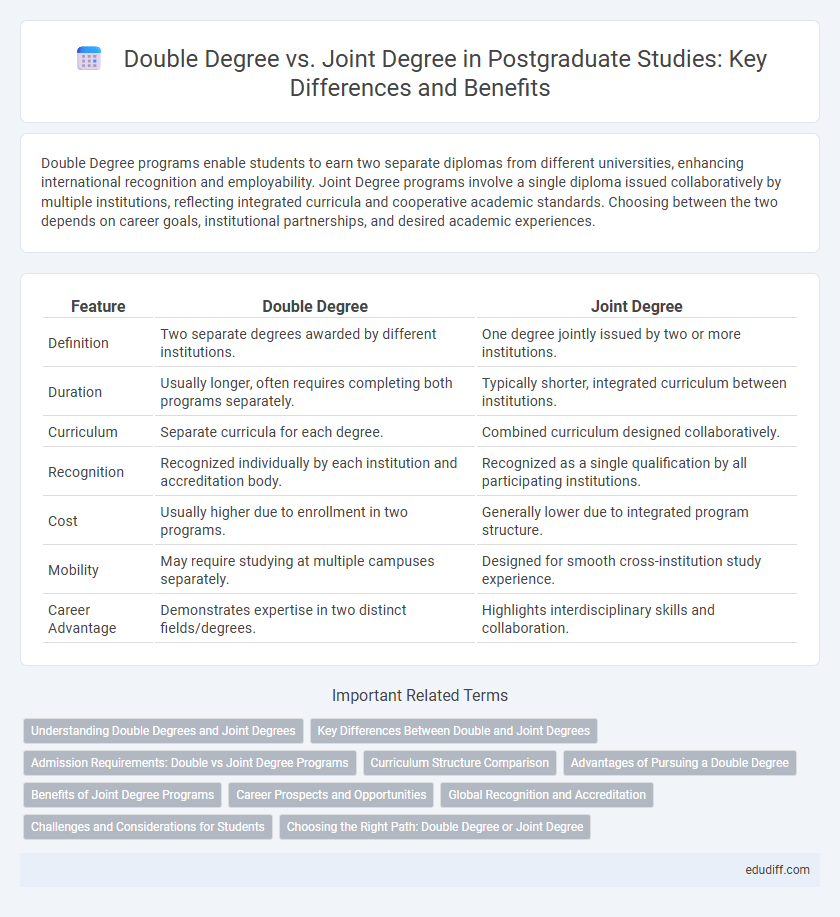Double Degree programs enable students to earn two separate diplomas from different universities, enhancing international recognition and employability. Joint Degree programs involve a single diploma issued collaboratively by multiple institutions, reflecting integrated curricula and cooperative academic standards. Choosing between the two depends on career goals, institutional partnerships, and desired academic experiences.
Table of Comparison
| Feature | Double Degree | Joint Degree |
|---|---|---|
| Definition | Two separate degrees awarded by different institutions. | One degree jointly issued by two or more institutions. |
| Duration | Usually longer, often requires completing both programs separately. | Typically shorter, integrated curriculum between institutions. |
| Curriculum | Separate curricula for each degree. | Combined curriculum designed collaboratively. |
| Recognition | Recognized individually by each institution and accreditation body. | Recognized as a single qualification by all participating institutions. |
| Cost | Usually higher due to enrollment in two programs. | Generally lower due to integrated program structure. |
| Mobility | May require studying at multiple campuses separately. | Designed for smooth cross-institution study experience. |
| Career Advantage | Demonstrates expertise in two distinct fields/degrees. | Highlights interdisciplinary skills and collaboration. |
Understanding Double Degrees and Joint Degrees
Double degrees involve earning two separate diplomas from two different universities after completing two distinct curricula, offering a broader academic experience and increased employability. Joint degrees result in a single diploma issued by partnering institutions that integrate their programs into one cohesive course, emphasizing interdisciplinary learning and international collaboration. Both options enhance postgraduate credentials but differ in structure, certification, and academic focus.
Key Differences Between Double and Joint Degrees
Double degrees involve earning two separate diplomas by completing the full requirements for each program, often extending study duration, whereas joint degrees combine curricula from two institutions into a single diploma, streamlining the academic process. Double degrees provide broader expertise and more credentials, while joint degrees emphasize interdisciplinary integration and collaboration between universities. Understanding these differences helps postgraduate students align their academic goals with the credential structure and career advantages offered by each option.
Admission Requirements: Double vs Joint Degree Programs
Admission requirements for double degree programs typically demand separate applications and acceptance criteria for each institution involved, including distinct language proficiency scores and standardized test results. In contrast, joint degree programs often streamline the admission process through a unified application system, requiring a single set of documents and consistent eligibility criteria across partnering universities. Understanding these differences helps prospective postgraduate students navigate application complexities and optimize their chances of enrollment.
Curriculum Structure Comparison
Double Degree programs offer students two separate diplomas by completing distinct curricula from two institutions, often requiring fulfillment of individual graduation criteria for each degree. Joint Degree programs combine curricula from partner universities into a single, integrated curriculum, culminating in one shared diploma recognized by all participating institutions. Curriculum structure in Double Degrees emphasizes parallel completion of two full programs, whereas Joint Degrees focus on harmonized coursework designed collaboratively to avoid redundancy and streamline academic requirements.
Advantages of Pursuing a Double Degree
Pursuing a double degree in postgraduate studies offers extensive academic exposure by allowing students to earn two separate qualifications from different institutions or disciplines, enhancing career flexibility and employability. This path provides a broader skillset through diverse curricula, enabling graduates to meet complex industry demands with interdisciplinary knowledge. Access to multiple alumni networks and global recognition further increases professional opportunities in competitive job markets.
Benefits of Joint Degree Programs
Joint degree programs offer students the unique advantage of earning two degrees with a cohesive curriculum, reducing total study time compared to pursuing separate qualifications. These programs foster interdisciplinary expertise and enhance employability by integrating diverse academic perspectives and skills. Graduates from joint degree programs benefit from stronger academic networks and international recognition, increasing opportunities in global job markets.
Career Prospects and Opportunities
Double Degree programs offer graduates two separate diplomas from partnering institutions, enhancing career prospects by broadening qualifications and increasing employability across international markets. Joint Degree programs grant a single diploma jointly issued by collaborating universities, fostering interdisciplinary expertise and demonstrating strong collaboration skills sought by global employers. Both pathways significantly boost opportunities in competitive job markets by showcasing advanced knowledge and diverse academic networks.
Global Recognition and Accreditation
A Double Degree involves earning two separate qualifications from two institutions, each accredited independently with global recognition, enhancing international employability. A Joint Degree, awarded collaboratively by two universities, holds a single diploma recognized across multiple countries, streamlining credential evaluation worldwide. Both pathways rely on the accreditation standards of participating universities, impacting their acceptance by global employers and academic institutions.
Challenges and Considerations for Students
Navigating Double Degree and Joint Degree programs presents challenges such as managing increased academic workloads, meeting distinct institutional requirements, and coordinating different credit systems across universities. Students must also consider potential visa regulations, cultural adjustments, and aligning graduation timelines to avoid delays. Thorough planning and clear communication with academic advisors are essential to successfully meet these program demands.
Choosing the Right Path: Double Degree or Joint Degree
Choosing between a double degree and a joint degree depends on your career goals and academic interests. A double degree typically involves completing two separate degree programs, resulting in two distinct diplomas that enhance employability in diverse fields, while a joint degree combines coursework from two institutions into a single credential, emphasizing interdisciplinary expertise. Consider factors such as program duration, curriculum overlap, and recognition by employers or academic institutions to select the right postgraduate path.
Double Degree vs Joint Degree Infographic

 edudiff.com
edudiff.com